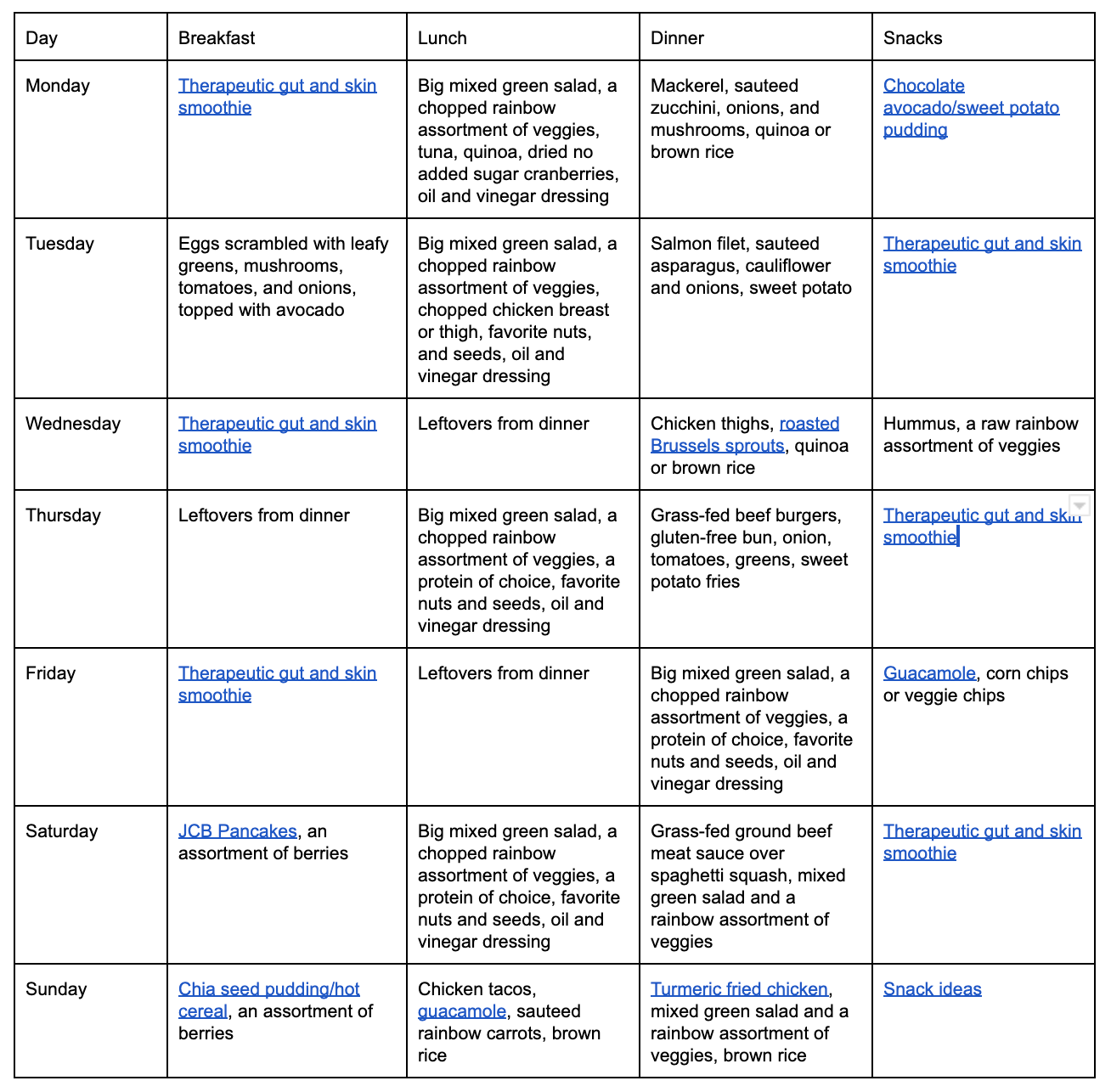a framework for healthy eating!
My #1 nutrition tip: Eat quality, nutrient-dense, whole, real foods
That's it. Really. Your health depends on it!
Your body runs off nutrients from the foods you eat. They are fuel. When that fuel is missing, imbalances develop, and symptoms and health problems follow.
Everything your body does requires fuel, including building and repairing healthy skin.
Any diet that excludes foods, food groups, and food categories puts you at risk. Your elimination diet and even your 'healthy' diet can be to blame.
Taking elimination diets and 'healthy' too far can lead to fear of food, disordered eating habits, eating disorders, and a lack of fuel that the body needs. It also doesn’t solve the root cause of your rashes and other chronic skin problems.
Nutrients from foods you eat even build neurotransmitters, which dictate your mood and play a role in mental health. Nutrient insufficiency and deficiency can contribute to depression, anxiety, behavioral problems in children (ASD and ADD/ADHD), and more.
A diet of whole, real foods means eating foods in their natural form. To shop for whole, real foods, go around the perimeter of the store. Avoid aisles, where packaged products are found.
When possible, opt for quality animal foods (organic, grass-fed, pastured, free-range, and wild-caught). Conventional animal products are inflammatory and high in omega-6 fats. Quality animal foods are rich in omega-3 anti-inflammatory fats.
Conventional seed oils are also high in omega-6 fats. Avoid rice bran, safflower, sunflower, corn, canola, cottonseed, soybean, and grapeseed oils, especially for cooking at high temperatures. Better cooking oils/oils, in general, are avocado oil, extra virgin olive oil, coconut oil, and butter and ghee.
Calories matter
An important component of a healing journey, and certainly when you are struggling with chronic skin conditions, is getting enough fuel. There is a higher metabolic need for fuel (you need more calories) when the body is healing. This isn’t a time for dieting or calorie restrictions. Elimination diets and ‘healthy’ diets can be problematic here too.
All calories are not created equal. Some provide value and nourish the body, while the same number of calories from the “wrong” sources depletes the body even further.
Calories from quality, nutrient-dense, whole, real foods help your body heal. They also maintain blood sugar levels, improve mood, and minimize cravings because they teach your brain to tell your stomach that you're full.
Calories from the “wrong” sources like processed foods and junk foods do the opposite. They can prevent proper healing, cause hormone imbalances, raise blood sugar levels, and cause you to overeat.
Other favorite recommendations
Chew thoroughly and eat slowly
Bitter foods for digestion (arugula, dandelion greens, ginger, kale, apple cider vinegar)
Probiotic foods (sauerkraut, kimchi, other fermented veggies)
Healthy fats (fatty fish like salmon, mackerel, and sardines, avocado/avocado oil, olives/olive oil, nuts, coconut/coconut oil, grass-fed butter, ghee, chia, and flaxseeds)
Variety of brightly colored vegetables and fruits, and herbs and spices
Protein (one of the most important nutrients for healing chronic skin problems)
Iron-rich foods: quality animal proteins including beef, poultry, seafood, pork, etc. (dark meat is higher in iron), spinach, legumes, pumpkin seeds, quinoa, broccoli, raisins, prunes, figs, sweet potatoes, blackstrap molasses
Eat iron-rich foods away from calcium/calcium-rich foods (calcium inhibits iron absorption) and with vitamin C/vitamin C-rich foods (C enhances iron absorption)
Vitamin A-rich foods: beef liver, cod liver oil, egg yolk, butter, sweet potato, pumpkin, carrot, cantaloupe, mango, spinach, broccoli, kale, collard greens, butternut squash
Quercetin and anthocyanins rich foods (both can help stabilize mast cells and histamine release/manage allergy symptoms)
Apples, Broccoli, Citrus, Berries, Cherries, Grapes, Red cabbage, Red onion, Herbs/spices (parsley, thyme, turmeric, ginger)
Hydrate (plain filtered water)
Prior to 6 months of age, baby should get all necessary fluids from breastmilk or formula
Introduce sips of water when baby starts eating solids (around 6 months of age)
1 glass of water per year of age for kids
8-10 glasses per day for adults
Limit/avoid gluten, processed foods, junk foods, added sugar, added salt
Aloe vera juice can help with constipation and promotes the growth of good gut microbes and gut health
Limit/avoid gluten, processed foods, junk foods, added sugar, added salt, and high-fat diets (these contribute to gut hyperpermeability, which is leaky gut)
questions to ask yourself about the foods you eat
Am I eating different foods from all food groups and categories of food as much as I can?
Am I eating a rainbow assortment of vegetables and fruits?
Am I eating quality, complete protein with each meal?
Am I eating healthy fats with each meal?
Am I eating complex carbohydrates every day?
Am I drinking enough water every day?
Am I relaxed and present while I’m eating?
Am I eating slowly and chewing my food well enough?
Am I aware of how my body feels when I eat different foods?
Am I eating intuitively and recognizing when I’m hungry and when I’m full?
Kids: Shopping list , what to eat, & How Much
Non starchy vegetables (fill ½ your plate at each meal, a fist is a serving size)
Leafy greens
Bright colors
Sulfur containing (onions, mushrooms, broccoli, cabbage)
Fermented foods (probiotics, 1-2 Tbsp most days, can feed littles the liquid too, especially if not taking a probiotic supplement)
Sauerkraut, kimchi, and other fermented vegetables, as well as yogurt and kefir
Healthy fats (1 serving with each meal, do not restrict fats in children, serving sizes)
1 tsp oil (olive or avocado, coconut oil, ghee, grass fed butter)
1/2 oz nuts/seeds (ground if needed to prevent choking)
2-5 olives (chopped if needed to prevent choking)
1-2 Tbsp avocado
Healthy fat filled foods include salmon and other fatty fish, whole eggs (if tolerated)
Quality protein (1 serving with each meal, a palm size is a serving)
Grass fed, pastured, free range, and wild caught organic animal products are complete proteins and contain all the amino acids your body needs and can't make
Plant based protein sources include tofu, tempe, lentils, chickpeas, nuts and seeds, quinoa, chia seeds, and beans
Protein powder (¼-½ scoop, add to smoothies, oatmeal, and chia seed pudding)
Starchy vegetables and complex carbohydrates (1-3 servings daily, small fist size is a serving)
Sweet potatoes, yams, squash, and other root vegetables like carrots, quinoa, brown rice, steel cut oats, buckwheat, and other whole grains
These are prebiotic and feed good gut bugs
Fruit (1-3 servings daily, handful of berries, or ½ - 1 piece of whole fruit is a serving)
Low sugar fruits like berries, and granny smith apples
Kiwi fruit is prebiotic
Herbs and spices (antioxidant and anti-inflammatory)
Enjoy liberally
Serving sizes noted are based on kids-sized palms/handfuls
Tips for picky eaters
Adults: Shopping list , what to eat, & How Much
Non starchy vegetables (fill at least ½ your plate at each meal)
Leafy greens
Bright colors
Sulfur containing (onions, mushrooms, broccoli, cabbage)
Fermented foods (probiotics, ¼ cup most days, especially if not taking a probiotic supplement)
Sauerkraut, kimchi, and other fermented vegetables, as well as yogurt and kefir
Healthy fats (a serving with each meal, about 1-2 Tbsp of oil and nut and seed butters, ¼ cup nuts and seeds, or ¼ an avocado)
Nuts (Brazil and others) and seeds and their butters, olive and avocado oils, avocado, olives, grass fed butter and ghee, coconut oil, and foods like whole eggs (if tolerated), and fatty fish like wild caught salmon (essential omega 3s) are examples of foods rich in healthy fats
Quality protein (a serving with each meal, about the size of your palm)
Grass fed, pastured, free range, and wild caught organic animal products are complete proteins and contain all the amino acids your body needs and can't make
Plant based protein sources include tofu, tempe, lentils, chickpeas, nuts and seeds, quinoa, chia seeds, and beans
Protein powder (1-2 scoops, add to smoothies, oatmeal, and chia seed pudding)
Starchy vegetables and complex carbohydrates (1-3 servings daily, ¼ - ½ sweet potato or yam, ¼ - ½ cup quinoa or brown rice, or ¼ - ½ cup oatmeal)
Sweet potatoes, yams, squash, and other root vegetables like carrots, quinoa, brown rice, steel cut oats, buckwheat, and other whole grains
These are prebiotic and feed good gut bugs
Fruit (1 serving daily, ¼ - ½ cup berries, or 1 piece of whole fruit)
Low sugar fruits like berries, and granny smith apples
Kiwi fruit is prebiotic
Herbs and spices (antioxidant and anti-inflammatory)
Enjoy liberally
70% or higher dark chocolate as a treat option (a serving is 1 oz)
Sample, 7-day Meal Plan - Mix and Match!
Get the recipes
Therapeutic gut and skin smoothie (customized when we work together)







